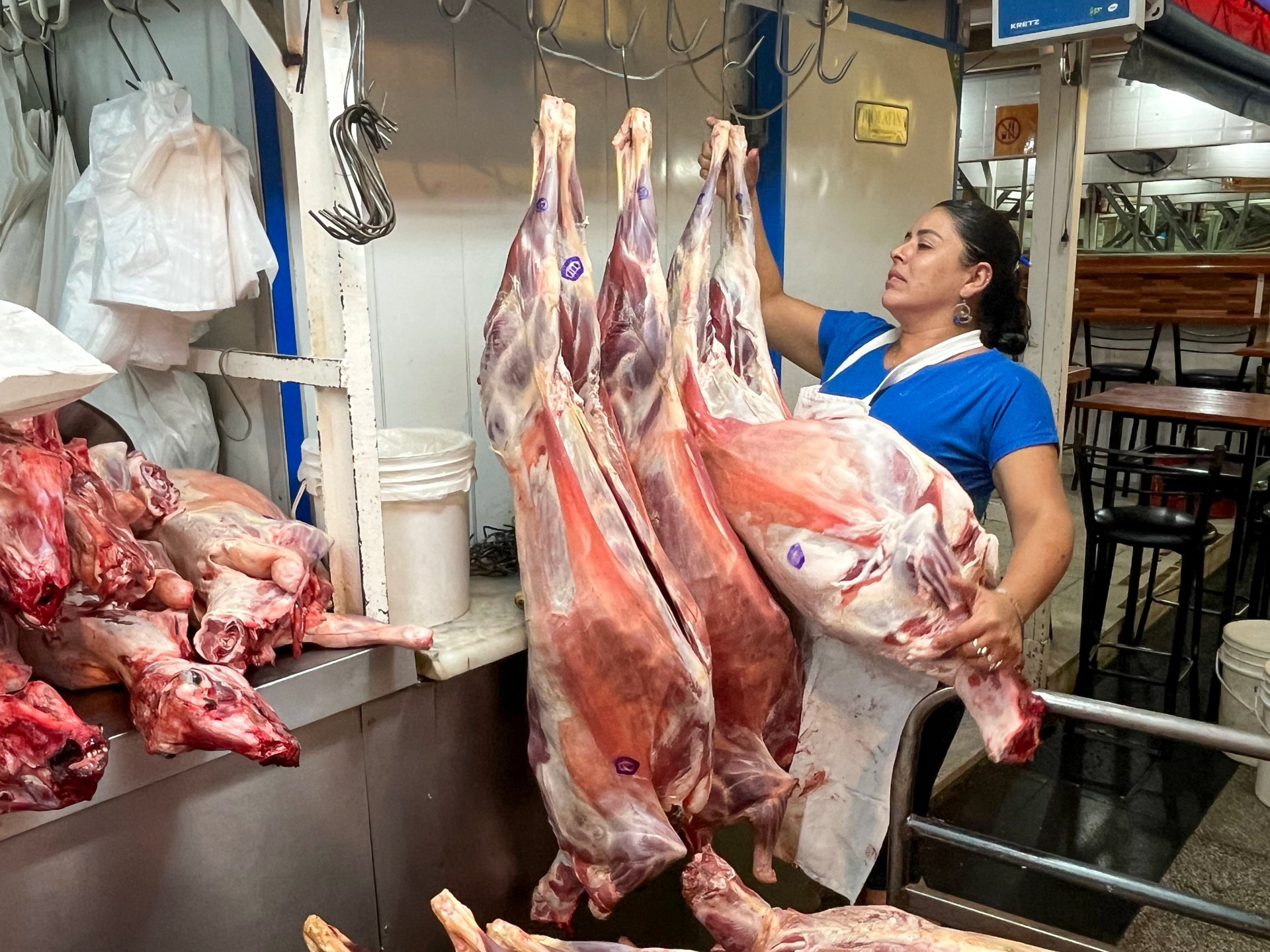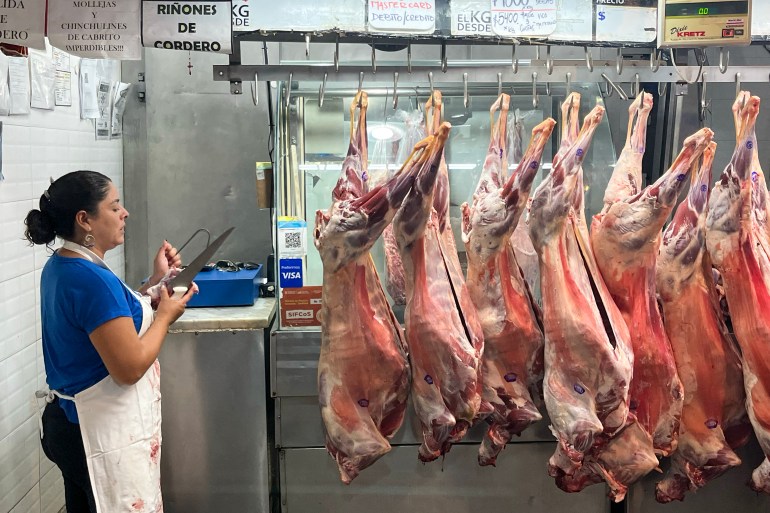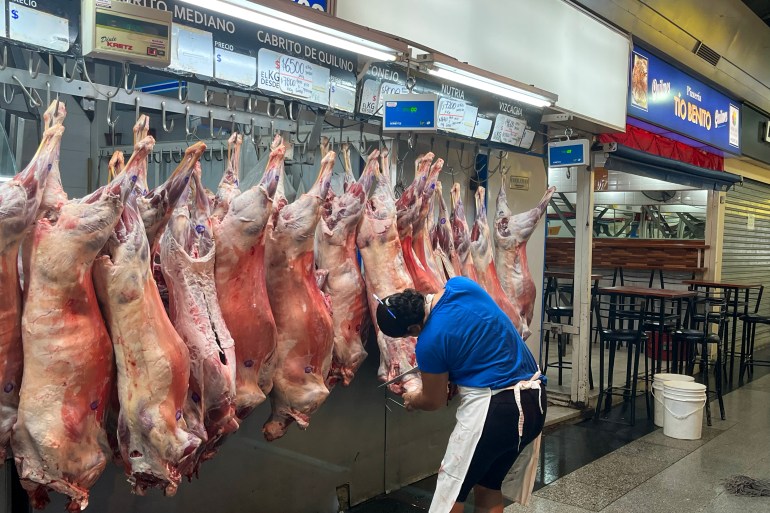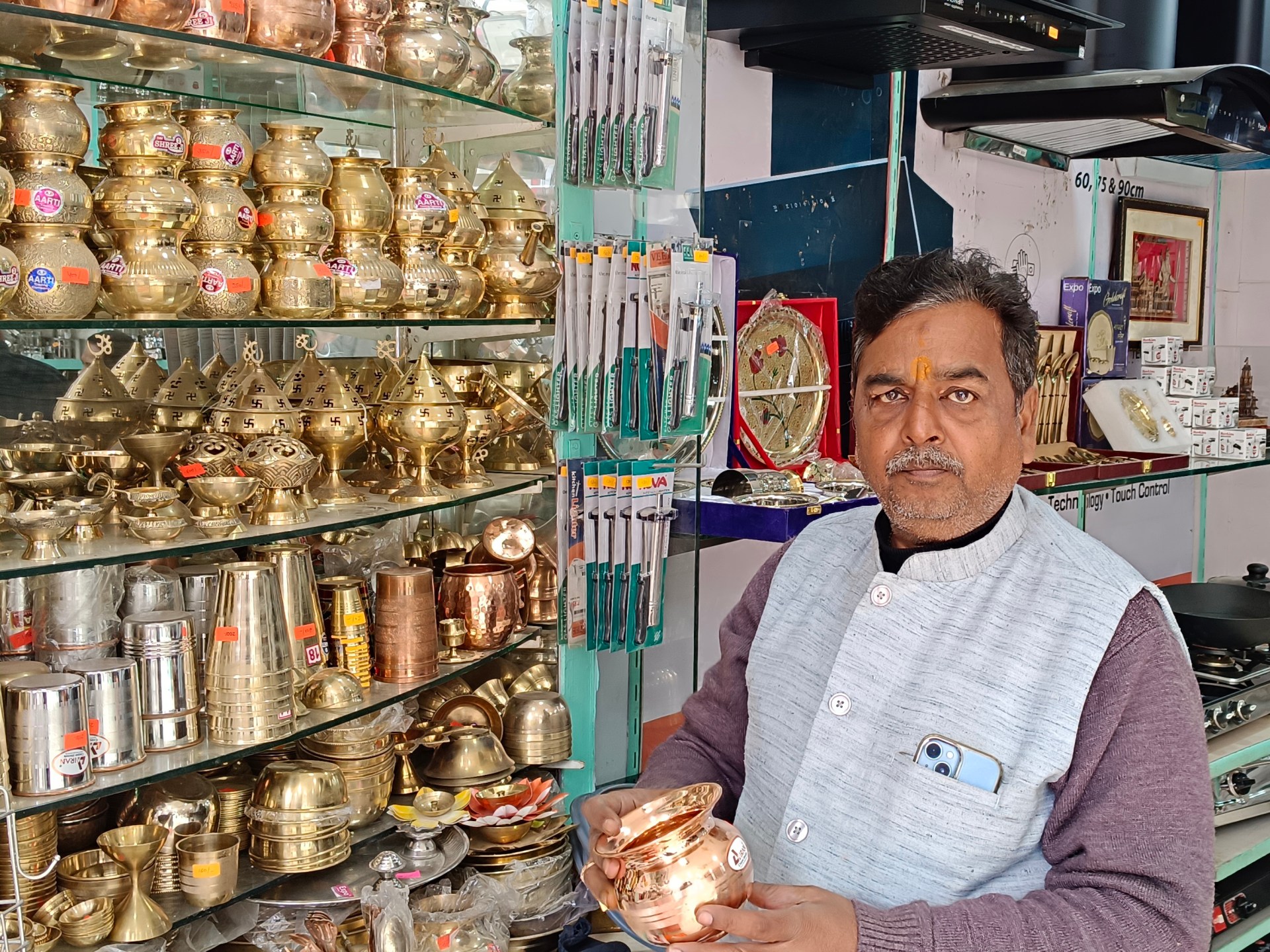
Cordoba, Argentina – All it takes is a brisk stroll through the Mercado Norte, a nearly century-old indoor food market in this city, to realize that meat is the domain of men in this most carnivorous of countries. Behind the glass counters of the carnicerias, or butcher shops, that make up the majority of the market’s food stalls, male butchers hold court, knife in hand, while women, if any are in sight, are relegated to the checkout.
The bloodstained apron hanging around her neck marks Maru Diaz as an exception to the rule.
On a recent Tuesday, Diaz worked with two other butchers, both men, to shape goat carcasses into recognizable retail cuts: ribs, fillets and bone-in drumsticks, the meat of which has become a popular filling for empanadas. This is not a task for the faint of heart. First, the 23kg animal is hung on a hook, its head is chopped off and a knife is hacked along its spine to cut the carcass in half.
“I work in a man’s world,” Diaz said matter-of-factly, with goat heads piled around her feet in what almost seemed like a religious ritual. After seeing her wielding a knife or cleaver, some men expressed their surprise in condescending comments that angered her: “Be careful. You will get hurt” or warnings to beware of the “armed woman”.
“I like what I do,” said the 36-year-old, whose black hair was tied in a bun. “But you really have to want it.”
And it seems that more and more women want it.
The butcher shop, like “Disneyland”
Women like Diaz are increasingly making their mark in the industry, making names for themselves through their work behind meat counters, and some are even opening their own carnicerias. At the same time, new training opportunities aim to further democratize the workplace and spread butchering know-how, creating more entry-level opportunities for women and other outsiders.
It’s a shift that has outsized symbolic significance in meat-loving Argentina, where asado, or barbecue, is king, where carnicerias grace nearly every block and where locals are braving a crippling economic crisis and triple-digit inflation to retain their title of the world largest steak consumers per capita. Even more than Tango or Malbec wine or Borges or the legend of Maradona – well, maybe not Maradona – steak is at the heart of Argentinian identity.
Macarena Zarza, 29, understands this all too well. She got her first job as a teenager in a butcher shop, a product of chance and necessity. She had dreamed of a career in law enforcement but dropped out of high school to support her family after her father died of cancer. She responded to an ad for a cleaner at her neighborhood carniceria in the sprawling Buenos Aires metropolitan area.
Months passed, then years. When a colleague who was responsible for preparing milanesas, or breaded cutlets, was sick, she stepped in for him. Later, she was assigned by supervisors to grind beef, press hamburgers and debone some cuts of meat. Soon she was spending her lunch breaks and evening hours shadowing other butchers and learning carving from her boss.
“It took me two years to get to the counter,” Zarza said.
The more Zarza learned, the more her passion grew. She now speaks of the need to have “respect” for the carcasses when slaughtering, and compares her passion for the craft to the enthusiasm of most Argentines for the national soccer team. She opened her own carniceria, where she single-handedly slaughters 15 cattle a week, and traveled to France to hone her skills with master craftsmen. Even more satisfying, she convinced customers who initially told her that a butcher shop was not a place for women or that they would rather wait for a male butcher to come before placing their order. Nowadays, Zarza runs a meat processing plant that supplies area carnicerias.
“I never got a degree or a diploma,” she said. “But I show people what I can do with my knives.”

Victoria Vago’s path to becoming a butcher depended on a career change. As a political science graduate, she always felt “like she was in Disneyland” when she was surrounded by meat in a butcher shop. In 2018, she quit her office job in the Buenos Aires city government to do an apprenticeship at a local carniceria.
She never looked back.
Good technique is better than pure strength
Vago and Zarza said people who don’t approve of female butchers tend to view brawn and brawn as job requirements. But that is a misunderstanding and an outdated one at that. With appropriate training and in-depth knowledge of carving techniques, women can run a carniceria just as well as any other man. In fact, an overreliance on physical strength during the slaughter process could be a sign that something is wrong, they said. According to Vagos and Zarza’s telling, butchering at its best is a kind of art form, with butcher knives more similar in spirit to a sculptor’s chisel than a miner’s pickaxe.
“Strength is just part of it. If you work in a place that is properly equipped, if you have good knife technique and know where to cut, you’ll be fine,” said Vago, who at 157cm (5ft 2in) is less than half of one typical side weighs from beef.
“Technology is what is making this no longer just a man’s thing,” Zarza added.
Although there is no official data showing the gender gap in Argentina’s meat industry, women have reached it over the past year highest participation of the entire workforce in the country’s history, according to government reports.
In conversations about the Argentine meat industry, the word “herencia,” or heritage, often comes into the spotlight. Because despite the nationwide passion for meat and despite the ubiquity of carnicerias across the country, butcher training is still a haphazard process with no formal pipeline or vocational training programs for aspiring butcher talent.
This informality tends to reinforce the male structure of the industry. Male butchers invite their sons, nephews or friends to work in their business – and one day take it over – and also inherit an appreciation for the profession.
“The knowledge of slaughter is family-based,” Zarza said.
Luis Barcos is trying to change that.
Training the next generation of butchers in Argentina
A trained veterinarian, Barcos is known for introducing the Wagyu cattle breed to Argentina in the late 1990s. He currently headed the National Food Safety Administration serves as the only Argentine member the French Meat Academy. His latest project is the Buenos Aires-based Institute of Meat Sciences and Trades, which will open later this year Debut of a butcher coursea mix of classroom teaching and practical workshops.
“There has never been a school for training butchers in Argentina,” said Barcos. “The passing of the profession from a father to his son or from a boss to his employee is a kind of knowledge transfer that is very valuable and has created a large workforce, but I thought we could do something more standardized and professionalized.”
A shift toward standardization “would undoubtedly significantly increase female participation in the industry,” he said.

The Institute of Meat Sciences and Trades boasts the support of major players such as the University of Buenos Aires, several federal agencies, a leading meat industry journal and the French Embassy in Argentina. (Barcos dreams that Argentine butchers in Argentina will enjoy the same reverence and respect as French food artisans in their country.) But other, more homegrown training initiatives are also gaining momentum.
In the sparsely populated province of La Rioja in Argentina’s mountainous northeast, Soledad Andreoli is co-owner of a slaughterhouse and a local chain of carnicerias. This month she founded a free “school for butchers” by converting part of the slaughterhouse hall into a training facility.
Andreoli’s goal is to give local working-class women better job prospects, as most struggle to find opportunities outside of domestic work, an area in which there is little more than enough 97 percent of employees are female. She also hopes to help accelerate change in a “machista” industry that she says has systematically excluded women.
“Cultural changes, cultural revolutions do not happen suddenly. They are gradual. … To break down barriers, you have to find that starting point and put in your grain of sand.”
Women working in carnicerias are “a change that will…be permanent,” she said.
“We’re in a different era now.”






Recent Comments